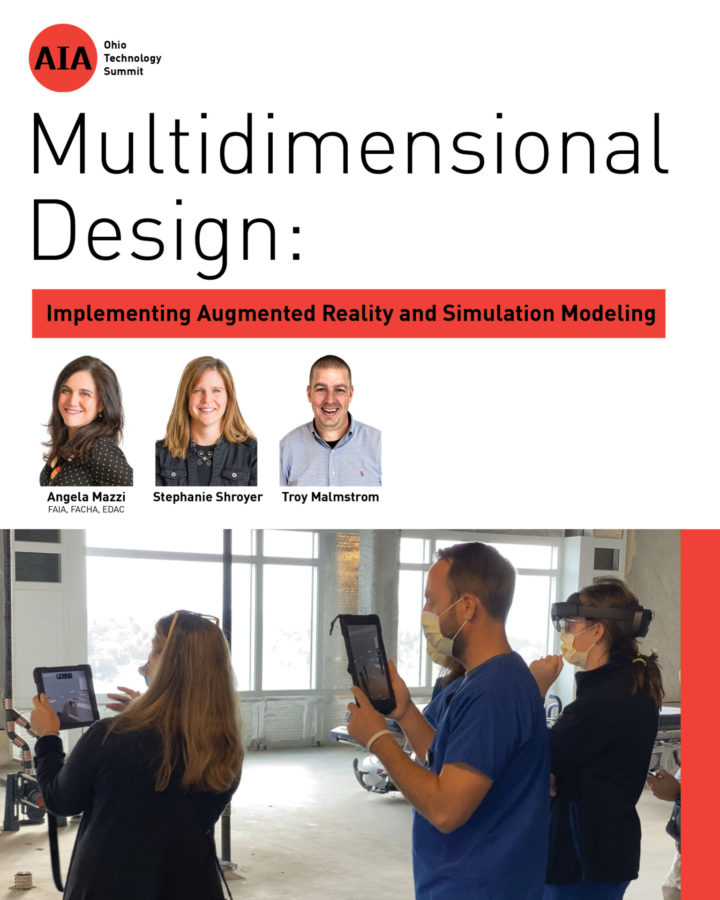Insights
Dec 5, 2022 _ insights
Multidimensional Design: Implementing Augmented Reality and Simulation Modeling
To have meaningful conversations about design choices, clients and user groups need to understand how a space will REALLY be used. Architectural plans, sections, and elevations, require a certain fluency to understand. Perspective renderings or virtual walkthroughs give a better picture but lack a good sense of distance or the way different elements outside of the chosen views relate to one another. This is especially true when it comes to trying to understand how multiple systems come together in the walls, ceilings, and floors of spaces.
In our presentation at the AIA Ohio Technology Conference, we used several case studies to show how we leverage technology to help our clients understand design in multiple dimensions. We also shared how we help clients flesh out their operations and understand space and other resource utilization using simulation modelling.
By mapping how staff and visitors truly use their spaces, we can simulate the proposed building use and find bottlenecks in these plans. From there, we’re able to determine if its best to modify the design, or the process, to obtain a more efficient use of the facility. We also reviewed how a design can be experienced using Augmented Reality (AR) to navigate a full-scale design model in real time and space. We shared our experience using an AR model to explore the design with facilities staff, contractors, and end-users within an existing shell space. AR models can enable better communication, help end-users decide between options; help IT staff locate equipment and visualize wiring and network infrastructure; and they can help contractors and facilities staff anticipate MEP pinch points and collisions.
Click here to view our slide presentation.
 Troy Malmstrom, is an associate principal and GBBN’s design technology manager. He believes that if we understand how building components and materials are fabricated, we can create more elegant design solutions, so he works with designers, manufacturers, fabricators, and builders to understand all the processes that feed into our projects and discover openings for creatively executing our design intent.
Troy Malmstrom, is an associate principal and GBBN’s design technology manager. He believes that if we understand how building components and materials are fabricated, we can create more elegant design solutions, so he works with designers, manufacturers, fabricators, and builders to understand all the processes that feed into our projects and discover openings for creatively executing our design intent.
 Angela Mazzi, FAIA, FACHA, EDAC is a principal and medical planner at GBBN. Harnessing studies on human psychology, research on our biological need for nature, and experience with Lean strategies, Angela creates exceptional environments that help patients heal and empower professionals to deliver exemplary care. She regularly presents and publishes her research in industry and peer reviewed journals and is sought out by Healthcare Design Magazine, the New York Times, and other publications to share her healthcare expertise with their readers.
Angela Mazzi, FAIA, FACHA, EDAC is a principal and medical planner at GBBN. Harnessing studies on human psychology, research on our biological need for nature, and experience with Lean strategies, Angela creates exceptional environments that help patients heal and empower professionals to deliver exemplary care. She regularly presents and publishes her research in industry and peer reviewed journals and is sought out by Healthcare Design Magazine, the New York Times, and other publications to share her healthcare expertise with their readers.
 Stephanie Shroyer is an associate principal at GBBN. She uses design to envelop people in environments that positively impact their mood and sense of well-being. Stephanie combines research, evidence-based-design, and cues from nature to craft healthcare facilities that help the healing process and make the work of the healer more efficient.
Stephanie Shroyer is an associate principal at GBBN. She uses design to envelop people in environments that positively impact their mood and sense of well-being. Stephanie combines research, evidence-based-design, and cues from nature to craft healthcare facilities that help the healing process and make the work of the healer more efficient.




